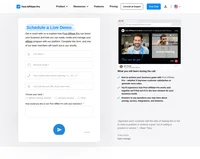Affiliate marketing is a great way to attract more potential customers to your e-commerce store at a relatively low cost. Over 81% of brands use affiliate marketing programs, so why shouldn’t you try it out too? But to make it profitable, you need to build an affiliate program that is well-tailored for your store.
Amazon has one of the most well-known affiliate programs. Of course, such a well-known brand couldn’t release a subpar affiliate program. And because of its quality, it delivers results – 40% of Amazon’s revenue comes from its affiliate marketing program.
Now that we’ve provided you with a little inspiration from this giant retailer, let’s get straight to the point. What should you do to create a good affiliate program for your e-commerce, optimizing it for effectiveness? Below you will find some useful tips and tricks that will help you get started.
1. Do research
Analyzing your competitors’ activities is the best place to start. Usually, you can find everything you need by Googling the right phrases. Learn from their entire affiliate programs – the commission levels, probable costs, the reach of their affiliate landing pages, etc. It may also be a good idea to sign up for one of their programs – it will give you a chance to observe how everything works from within.
You can also look for inspiration outside of your industry and examine affiliate programs of companies that don’t compete with you. Inspiration can be found anywhere. After carrying out the proper research, you will gain lots of valuable insights. Write what you learned down, and translate it into your abilities and needs.
2. Focus on your goals
Once you know how your competitors work, you need to analyze your business and define your own goals. For example, is your goal to increase website traffic, revenue, the average order value, or the conversion rate? Once you have decided what your goal is, then it’s time to look at the numbers.

Let’s assume you want to increase traffic on your website. You need to ask yourself by how much and in what period of time. Is it 10% in one month or 40% in half a year? These are important things to consider because they will determine the number of affiliates, partnerships, and also the budget you will need in order to achieve these goals.
3. Determine KPIs
KPIs are metrics that will determine whether your program is working as well as intended. So you need to consider and establish which KPIs you will measure. Here are some examples of such KPIs:
- Net sales
- Gross sales
- Click traffic
- Conversions
- Commissions
- ARPU (Average Revenue Per User)
Choose which ones should be your priorities and check how to measure them. The best way to do so is by implementing the appropriate software. Post Affiliate Pro will be a great choice here. Using this solution, you can keep an eye on your affiliate program, track your affiliates’ performance, and more. This software provides you with some in-depth reports, like top URLs, best performing campaigns, and top affiliates. There are also many types of commission models to choose from. Post Affiliate Pro also helps with the creation and distribution of promotional materials such as flash banners, HTML banners, and discount coupons.
4. Pick payment methods
To make your affiliate program profitable, you need to pick the type of payment method that will be the most suitable for your business model. You can choose commissions per action, such as:
- PPC (pay per click) – this model pays for the number of visitors brought to your website by your affiliates. It doesn’t matter if the visitors buy something or just simply scroll through your site and leave, the commission is paid out based on the number of clicks on affiliate links.
- PPL (pay per lead) – using this method, you pay your affiliates for generating leads, which equates to convincing users to take desired actions. What is the desired action? It could be subscribing to a newsletter or signing up for a free trial.
- PPS (pay per sale) – with this method, affiliates earn a commission only when a customer buys something from your store based on their referral.
If you want to use a more complex commission model, you can also think about using two-tier programs or lifetime commissions.
Two-tier programs can mix and match 2 commission models. For example, affiliates could earn a commission and a percentage of the amount earned.

Lifetime commissions are often leveraged with subscription-based services. Because subscriptions are recurring, affiliates receive money for a long time after the customer visits the store for the first time and purchases the subscription.
There are also multiple ways to pay your affiliates, such as gift cards or PayPal. If you want to learn more, check out this article.
5. Decide on your niche
You may be wondering why you should pick a niche if your industry is already perceived as one. Let’s assume that your company operates in the beauty industry. It sells make-up and skincare products.
When you start your affiliate marketing activities, it is worth focusing on just one product group. The target audience for both item groups may seem identical, but it really isn’t. A helpful tip might be to cooperate with those who have been around for a long time and have a loyal audience in that specific niche.
6. Find your affiliates
Take a closer look at who is active in the niche that you are interested in. You can find more ideas where you should look for your affiliates in this article.
Make a target list of your desired affiliate partners and start reaching out to them. But before you do that, create a list of conditions you want to offer them and make them as clear as possible. Determine commission levels and the cooperation terms such as the minimum number of promotional posts, the time frame of your cooperation, bonuses, and more. To attract the right affiliates, you need to offer quality perks and products. However, don’t be too compliant during negotiations.
7. Keep your affiliates engaged
Once your affiliate program is live, you need to keep tracking its performance and stay in touch with your affiliates. Don’t forget to do your best to keep them engaged, as fully engaged affiliate marketers can increase your profits by up to 21%. If you don’t have any solid plan about how to motivate your affiliates, you can get some inspiration from this article. There are many ways, just choose what suits you best.

Wrapping up
Creating the right affiliate program is not an easy thing. To make it work and deliver results, it must be well-tailored to your business. We hope that the above tips will help you create an effective affiliate program. Learn from your mistakes and remember that practice makes perfect. You can look back at this article at any time if you have any doubts about starting a new affiliate program.
Share this article
How To Find Affiliates to Sell Your Products
Discover over 10 successful strategies for finding high-quality affiliates in 2024 to boost your product sales. Learn to leverage influencers, join affiliate networks, and enhance your reach through SEO and social media. Maximize revenue with transparency and ongoing monitoring in your affiliate marketing program.
Explore seamless integrations with Post Affiliate Pro to enhance your affiliate marketing strategies. Discover solutions for e-commerce, email marketing, payments, and more, with easy integrations for platforms like 1&1 E-Shop, 2Checkout, Abicart, and many others. Optimize your affiliate network with these powerful tools.
9 affiliate marketing tools that’ll help you run your affiliate program
Discover 9 essential tools to supercharge your affiliate marketing program! From visual content creation with Visme to comprehensive management with Post Affiliate Pro and audience insights via Smartlook, these tools will boost your sales and refine your strategy. Dive in to maximize your affiliate success!
A guide to different types of affiliate tracking
Explore the comprehensive guide on affiliate tracking methods like cookie, postback URL, and IP tracking to optimize your affiliate marketing strategy. Learn how Post Affiliate Pro's advanced software ensures precise tracking, maximizes sales, and provides exceptional support for seamless affiliate cooperation. Unlock your brand's potential with cutting-edge tracking solutions today!
Effortlessly integrate your e-commerce site with Post Affiliate Pro and boost your affiliate program's success. Our expert team ensures seamless integration with your payment processor, handling technical issues along the way. Enjoy a free trial and free integration service, saving you time and maximizing your ROI. Join now and experience top-notch affiliate management with over 500 integration options.












